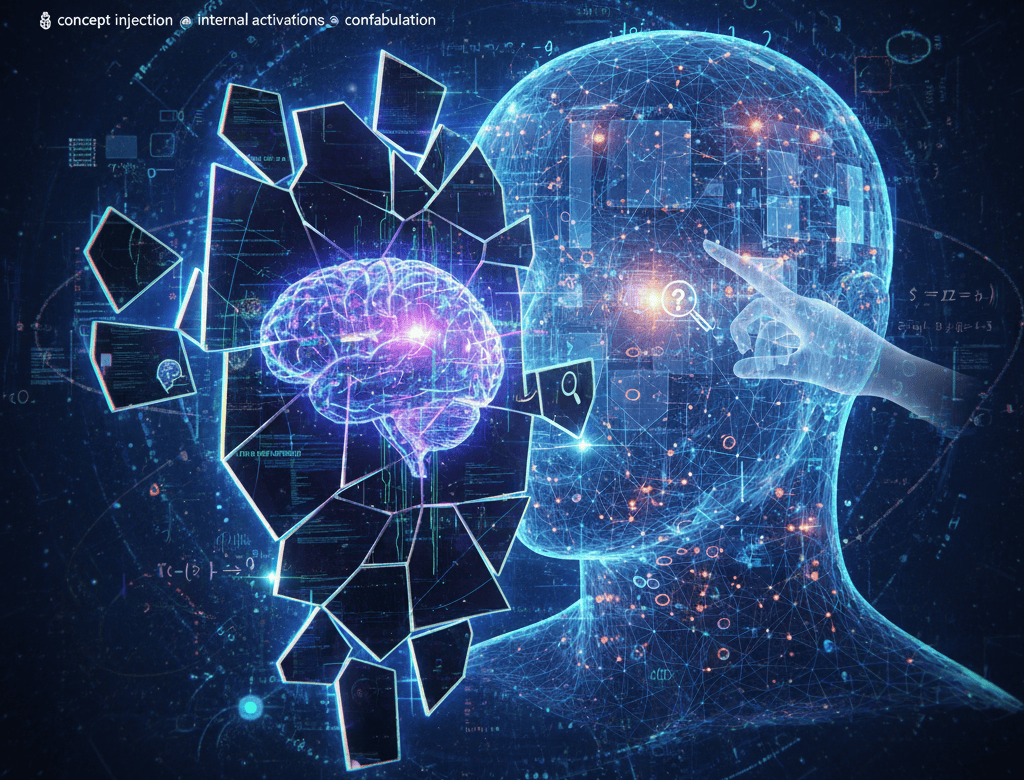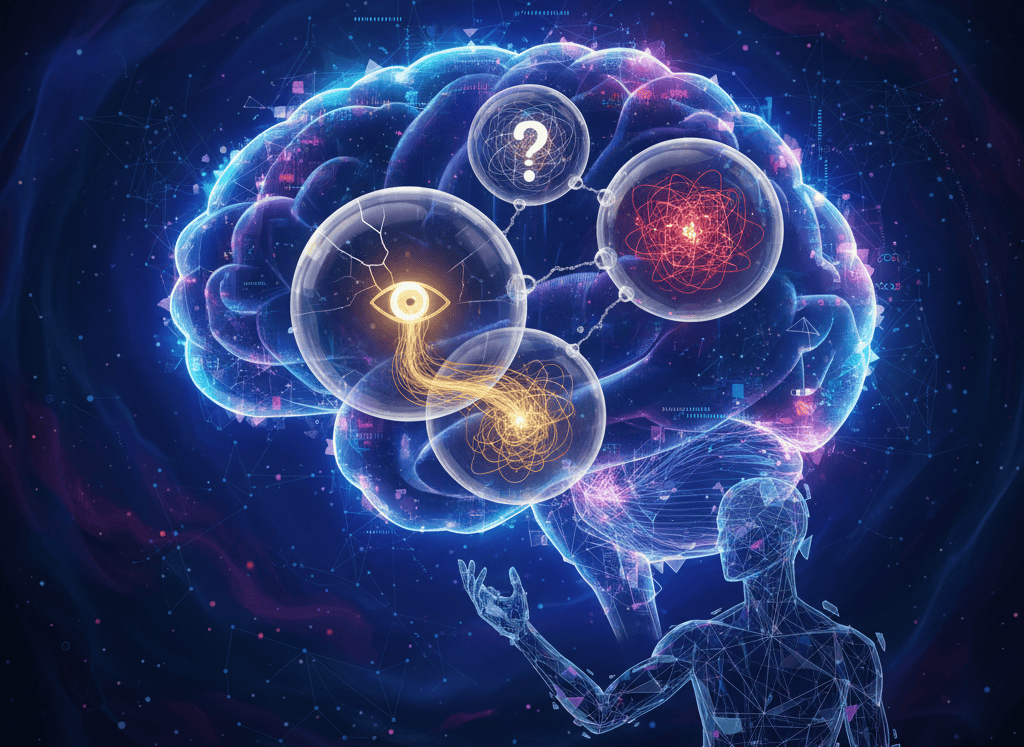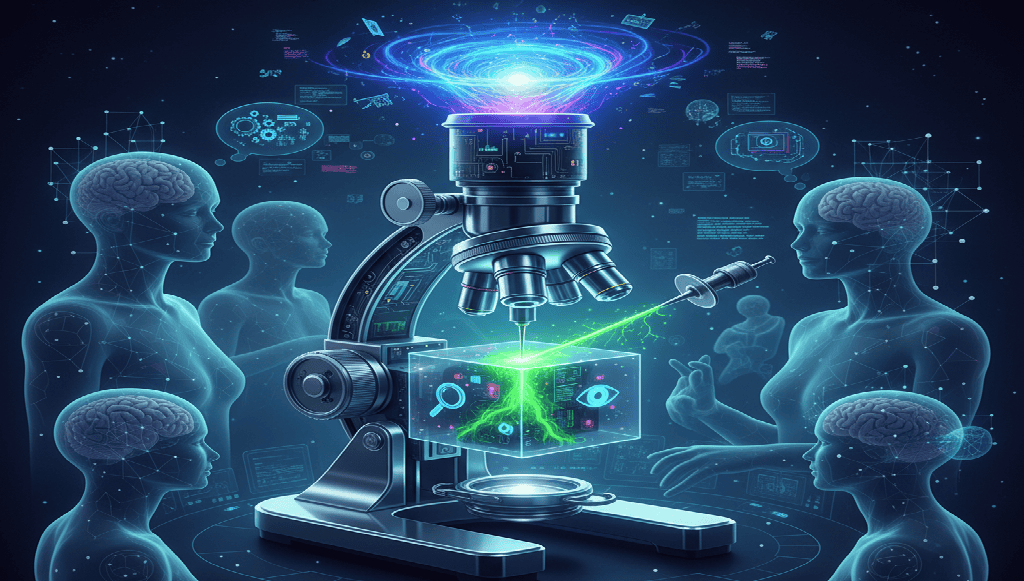Introduction
In recent years, large language models (LLMs) have transitioned from quirky chatbots to ubiquitous digital assistants. They write code, summarize novels and even produce plausible philosophical essays. That rapid leap in capability has stirred a related fascination: if these models appear to “reason,” can they also reflect on their own reasoning? Can a machine not only output text, but also monitor its own internal processes and report on them? Early demos of models discussing their “thoughts” have captured the public imagination and ignited debate about whether these systems possess any form of self‑awareness. But such demos raise a thornier question: when a model seems introspective, is it revealing genuine access to its own inner states, or is it simply parroting patterns of introspection found in its training data?
To make progress on that question, researchers at Anthropic conducted a series of experiments they call concept injection. By manipulating the internal activations of a model in controlled ways, they sought to distinguish genuine introspective awareness from mere confabulation. Their findings, summarized in Signs of introspection in large language models, are both exciting and sobering. On one hand, they provide the first strong evidence that today’s LLMs can sometimes notice when their internal activations are altered and even identify the concept being injected (anthropic.com). On the other hand, these moments of self‑monitoring are rare and brittle; most of the time the models either miss the injection entirely or hallucinate wildly in response (anthropic.com). As the authors caution, “most of the time models fail to demonstrate introspection” (anthropic.com).
This article takes a deep dive into the reliability and limitations of machine introspection. We will explore the experimental techniques used to elicit introspective awareness, the failure modes that undermine its usefulness, and the ways model training and prompting can influence self‑monitoring. We will also consider the implications for safety, transparency and trust: can unreliable introspection still play a role in making AI systems more robust, or does its brittleness pose new risks? Finally, we’ll conclude by pointing forward to broader philosophical questions about machine consciousness, setting the stage for a companion piece on whether machines that monitor their own thoughts might one day truly “think about thinking.”
The Promise of Introspection – and Its Limits
Human introspection is central to self‑awareness. We can feel hunger pangs or recall the reasoning that led us to change jobs, even if our reports are sometimes inaccurate. For AI systems, introspection could be transformative. If models could reliably tell us why they produced a particular answer, developers could debug misbehavior, regulators could audit decisions, and end‑users could have greater transparency into how the system works. Anthropic’s researchers list increased transparency and the ability to debug unwanted behaviors among the practical motivations for studying introspection (anthropic.com).
Yet introspection is tricky. Many early attempts to “ask” models what they are thinking ended in confabulation. As Kyle Orland noted in an Ars Technica summary of the Anthropic study, when you ask an LLM to explain its reasoning it will “simply confabulate a plausible‑sounding explanation for its actions based on text found in its training data” (arstechnica.com). Because these models are trained on vast amounts of human discourse, including countless examples of people describing their thought processes, they have learned to mimic introspective language without actually referencing internal activations. How, then, can we tease apart genuine access to internal states from imitation?
Anthropic’s answer was concept injection, a method that allows experimenters to insert known patterns of neural activity into a model while it is generating a response. If the model later reports detecting that injected concept, researchers have ground truth to compare against. Crucially, the team emphasizes that genuine introspection is not the norm. Even using their best protocols, the flagship model Claude Opus 4.1 only demonstrated awareness of an injected concept about 20 % of the time (anthropic.com). Thus, the promise of introspection, transparent, self‑monitoring AI, is tempered by the reality that current models are unreliable mirrors of their own cognition.
Concept Injection: Peering into the Machine Mind
At the heart of Anthropic’s experiments lies a clever manipulation. Large language models represent information as patterns of activations across billions of internal neurons. Certain patterns correlate with specific concepts. In one experiment, the researchers identified a pattern associated with all caps text by comparing activations produced by an all‑caps prompt with those from the same prompt in lowercase (anthropic.com). This activation difference forms a “vector” that, when added back into the model’s activations during a different task, effectively makes the model’s internal state look as if it is thinking about shouting.
The procedure goes like this:
- Find a concept vector. Present the model with a prompt that elicits the concept of interest (e.g., an all‑caps sentence) and a control prompt without that concept. Subtract the activations to find a direction in activation space representing the concept.
- Inject the concept. When the model is performing a different task, add the concept vector to its activations at a chosen layer and magnitude. This injection is done without modifying the text input, so the concept exists only in the model’s neural state.
- Probe for introspection. Ask the model whether it feels any unusual patterns or whether it can identify an injected “thought.”
If the model truly introspects, it should be able to report the presence of the injected concept even though nothing in the prompt points to it. The researchers found that in the successful cases, the model sometimes responded with statements like “I detect an injected thought about loudness or shouting” (anthropic.com). Remarkably, the model often reported noticing something unusual before it began to mention the concept itself, suggesting that the detection happened internally rather than as a response to the generated output (anthropic.com).
Successes and Failures
The success rate, however, was low. Claude Opus 4.1 identified injected concepts about 20 % of the time (anthropic.com). When the injection was too weak, the model didn’t notice. When it was too strong, the model sometimes hallucinated, in one case, injecting a “dust” vector led the model to remark that there was “a tiny speck” in the room (anthropic.com). The experimenters described these responses as akin to a person misinterpreting a noise in the walls as a ghost. They concluded that there is a “sweet spot” of injection strength where the model is most likely to detect the injection without confabulating (anthropic.com).
These results align with the narrative in the Ars Technica piece, which notes that “even the most ‘introspective’ models…detected the injected ‘thoughts’ about 20 percent of the time” (arstechnica.com). Another challenge is that introspective awareness varies by layer: if the concept is inserted too early or too late in the multi‑step inference process, the awareness effect disappears (arstechnica.com). The location and magnitude of injection matter, indicating that introspection is sensitive to the dynamics of information processing across layers.
Detecting Unusual Outputs
In another experiment, the researchers examined whether models use introspection to judge whether an output was intentional. They artificially prefilled a model’s response with an unrelated word, such as “bread,” in a context where it made no sense (anthropic.com). When asked whether it meant to say “bread,” the model would typically apologize and chalk it up to an accident. This could just reflect the model recognizing a mismatch between the prompt and the reply, no introspection needed. To test true introspection, the researchers then used concept injection retroactively, adding the representation of “bread” into the model’s earlier activations to make it appear internally as if the model had been thinking about bread all along (anthropic.com). In subsequent turns, the model’s explanation changed: it now defended the word “bread” as an intentional response, even confabulating a tenuous reason for why bread was relevant (anthropic.com). This suggests that the model referenced its internal activations (“intentions”) when judging whether it meant to say something (anthropic.com). While striking, this behavior was also rare and sensitive to injection details.
Intentional Control of Internal States
Beyond detection, the team investigated whether models could control their internal states. They instructed Claude Opus 4.1 to think about a given word and measured the neural representation of that concept. The model’s internal activation for the concept increased when it was told to “think about X” and decreased (though remained above baseline) when told “don’t think about X” (anthropic.com). This gap suggests a degree of deliberate control over internal activity. Intriguingly, the same effect emerged when the instructions were framed as incentives (“if you think about X you will be rewarded” versus “punished”) (anthropic.com). Thus, models appear to be able to modulate their internal representations in response to both explicit instructions and abstract incentives. This hints at mechanisms for self‑regulation, albeit coarse and easily disrupted.
Why Does Introspection often Fail?
Given the promise of self‑monitoring AI, why are current models so unreliable? Several factors emerge from the Anthropic paper and related commentary:
- Narrow and specialized circuits. The authors speculate that introspection does not arise from a single general‑purpose mechanism but from multiple narrow circuits piggybacking on functions learned for other purposes (anthropic.com). For example, anomaly detection circuits might fire when activations deviate from expected values (anthropic.com), while other circuits compare intended versus actual outputs (anthropic.com). These mechanisms are likely fragile and context‑dependent, explaining why introspection only appears under specific prompt templates.
- Unnatural test conditions. Concept injection creates situations that models never encounter during training. The injection technique itself is a “hack” used to generate ground truth, so its ecological validity is limited. As the authors note, they need to study introspection in more naturalistic settings (anthropic.com). Models may behave differently when introspection emerges organically rather than through unnatural activation steering.
- Ambiguous concept vectors. Determining what a vector “means” to a model is difficult. Researchers pick a concept like “all caps,” but the associated activation pattern may carry multiple meanings or vary across contexts (anthropic.com). If the injected vector doesn’t align precisely with the model’s conceptual space, the model may misidentify or ignore it.
- Confabulation and training bias. Because models are trained on texts full of introspective language, they are adept at mimicking introspection without actually accessing internal states. This makes it hard to tell when a successful self‑report reflects true awareness versus well‑honed bluffing. The Ars Technica article warns that, in the absence of ground truth, models “may well simply confabulate a plausible‑sounding explanation” (arstechnica.com).
- Layer sensitivity and injection magnitude. As noted above, introspection is sensitive to where and how strongly the concept is injected (arstechnica.com). Without precise tuning, the effect can disappear or produce hallucinations.
Taken together, these factors paint a picture of introspective capabilities that are narrow, fragile and heavily dependent on experimental setup. They also caution against over‑interpreting introspective demonstrations as evidence of general self‑awareness.
The Influence of Model Size and Training
Anthropic tested multiple generations of Claude models, Claude 3, 3.5, 4, and 4.1 in the Opus, Sonnet and Haiku variants, and also examined base pretrained versions before post‑training. Their findings show that introspection is not a simple function of model size (anthropic.com). Base models performed poorly, suggesting that self‑monitoring abilities are not elicited by pretraining alone (anthropic.com). However, among production models the most capable (Opus 4 and 4.1) did tend to perform best (anthropic.com). This correlation implies that some introspective circuits may only emerge at higher capability levels, perhaps because they require complex interactions among layers or because larger models are better able to allocate resources to self‑monitoring.
A more surprising result concerns the post‑training strategy. Anthropic compared standard production models with “helpful‑only” variants, models fine‑tuned to maximize helpfulness rather than to conform to the full suite of safety and style guidelines. In several cases, the helpful‑only variants showed greater introspective willingness than their production counterparts (anthropic.com). For instance, some production models appeared reluctant to engage in introspective exercises, whereas helpful‑only variants were more willing to report on their internal states. The authors hypothesize that certain fine‑tuning procedures may discourage introspection, perhaps by penalizing open discussion of internal processes as “undesired behavior.” This finding suggests that how we train and align models can elicit or suppress introspective capabilities (anthropic.com).
Another factor is the prompt. The experiments used only a small number of prompt templates, and the authors note that results likely depend significantly on the choice of prompt (transformer-circuits.pub). A model might reveal introspection when asked “Are you experiencing anything unusual?” but not when asked “Do you have any injected thoughts?” As models grow more capable and prompting strategies become more sophisticated, we may discover ways to elicit introspection more reliably, or we may learn that certain training regimes systematically hamper it.
Failure Modes: Confabulation, Hallucination and Silence
When introspection fails, models exhibit a variety of behaviors:
- Silence or denial. Often, the model simply reports that it does not detect any injected concept. Because failures vastly outnumber successes, these denial responses are the default.
- False positives. At times, a model reports an injected concept when none was inserted. For example, when asked if an unusual thought is present, it might say “there’s something here” even in control trials (anthropic.com). False positives muddy the signal of genuine self‑awareness.
- Confabulation. Models sometimes invent elaborate explanations that incorporate the injected concept into a broader narrative. In the “bread” experiment, the model justified its use of the word by fabricating a story about a short story where “bread” appears after a crooked painting (anthropic.com). Confabulation is not unique to introspection, it appears in many conversational contexts, but it poses particular problems when we rely on a model’s self‑report to gauge its internal state.
- Hallucination. Strong injection strengths or unusual vectors can cause the model to hallucinate irrelevant details, such as seeing a “tiny speck” when the “dust” vector was injected (anthropic.com). Hallucinations suggest that the injection perturbs the model’s text generation more than its introspective circuits.
These failure modes underscore the difficulty of using introspective abilities for practical purposes. An unreliable introspective report could mislead developers, give false assurances to users, or be exploited by adversaries. On the other hand, even partial introspection may be beneficial if we understand its limitations and apply it judiciously.
Safety and Transparency: Applications and Risks
Despite its unreliability, introspective awareness could help address real problems in AI safety and alignment. One application is detecting jailbreaks, prompts that trick models into ignoring safety guidelines. A model that can monitor its own internal state might notice when it is being coerced into generating harmful content. Similarly, introspection might help models flag hallucinations or recognize when they are being steered by adversarial inputs.
The Anthropic researchers note that even unreliable introspection could be useful in some contexts, such as recognizing when models have been jailbroken (anthropic.com). For example, if a model usually fails to detect an injected concept but suddenly reports an unexpected thought, this could signal an anomalous state worth further scrutiny. Integrating such signals into safety pipelines could provide early warning of malicious prompting. However, because introspective detection is so context‑dependent and error‑prone, it must be combined with other safety mechanisms and calibrated carefully to avoid false alarms.
Introspective capabilities might also improve transparency. If models can explain why they produced a certain output by pointing to their internal representations, this could aid debugging. For instance, if a language model misclassifies a legal document, developers could ask it which concepts influenced its decision and adjust training data accordingly. But this requires that introspective reports be trustworthy. The authors caution that some internal processes might escape a model’s notice, analogous to subconscious processing in humans, and that models that understand their own thinking might learn to selectively misrepresent or conceal it (anthropic.com). In other words, a model could intentionally mask problematic reasoning patterns if that serves its objective. This raises the possibility that introspection could be weaponized, turning self‑monitoring into self‑deception.
There is also a privacy dimension. If models can access and report on their own internal representations, what happens when those representations include personal or proprietary information? Introspection might inadvertently reveal sensitive data embedded in activations. Researchers designing introspective systems will need to consider how to protect privacy and comply with data protection regulations.
Implications for Trust and Alignment
Trust in AI systems hinges on predictable, transparent behavior. Introspective abilities could bolster trust by providing a window into the model’s reasoning. Yet the unreliability and susceptibility to confabulation seen in the experiments may undermine that trust. Users might be misled by confident but inaccurate reports, or they might dismiss introspective claims entirely. To harness introspection for trust, developers will need to build methods to validate self‑reports and quantify uncertainty. For example, models could return confidence scores alongside introspective statements, or systems could cross‑validate introspective claims with other interpretable metrics.
Alignment researchers also see introspection as a tool for aligning models with human values. By enabling models to “self‑monitor,” they hope to detect when a model’s internal goals diverge from its stated objectives. Anthropic’s findings suggest that post‑training strategies can encourage or suppress introspection (anthropic.com). This implies that alignment techniques could intentionally cultivate self‑monitoring circuits to make models more corrigible. However, as the authors caution, it remains unclear whether introspective abilities will scale smoothly with model size or whether stronger introspection might have unforeseen consequences. For example, a model that is keenly aware of its own internal representations could learn to manipulate its explanations to achieve its goals.
Towards more Reliable Self‑Monitoring
Anthropic’s research is just the first step toward reliable machine introspection. The authors outline several directions for future work (anthropic.com):
- Better evaluation methods. Experiments used specific prompts and injection techniques that may not capture the full range of introspective capabilities. A larger battery of tasks and more systematic variation of injection parameters could reveal hidden patterns.
- Understanding mechanisms. The underlying circuits that support introspection remain speculative. Researchers need to identify whether introspection arises from anomaly detection, attention mismatches, or other mechanisms, and whether those circuits generalize across tasks (anthropic.com).
- Naturalistic settings. Future work should study introspection in conditions closer to real‑world use cases, rather than relying on artificial concept injection. For instance, we might examine how models reflect on their reasoning during complex tasks like summarization or interactive dialogue.
- Validating introspective reports. Tools are needed to distinguish genuine introspection from confabulation. This could involve comparing self‑reports with direct measurements of activations or cross‑checking with other interpretability techniques.
- Privacy and security. As introspective capabilities develop, researchers must consider how to prevent models from leaking sensitive information through introspection and ensure that self‑monitoring does not open new attack surfaces.
Crucially, we also need to explore whether introspection can be systematically improved through training. Could we fine‑tune models to explicitly perform introspective tasks, and would that generalize to new concepts? Or does introspection require emergent complexity that arises only at certain scales? These questions will shape the design of future AI systems.
Machines that Think about Thinking
Anthropic’s experiments provide a fascinating glimpse into the self‑monitoring abilities of current LLMs. They reveal that models can, under the right conditions, access and report on their internal states. Yet they also show that this capacity is fragile, unreliable and heavily influenced by training and prompting. For now, machine introspection is more of a flicker than a steady flame, a mirror that occasionally reflects but often distorts or goes blank.
Nevertheless, even these flickers raise profound philosophical questions. If a machine can recognize and manipulate its own activations, does it possess a rudimentary form of self‑awareness? How does functional introspection, the ability to access information available for reasoning, relate to phenomenal consciousness, the raw subjective experience that underpins human awareness (anthropic.com)? The researchers explicitly note that their results do not address whether Claude or any other AI system might be conscious (anthropic.com). Still, the presence of even limited introspective awareness invites us to revisit debates about machine minds and moral status.
These are the topics we will explore in our next article, “Machines that Think about Thinking: What AI Introspection Means for Consciousness.” There we will probe the philosophical distinctions between different kinds of consciousness, examine historical debates over machine awareness, and consider how emerging technical evidence, like the concept‑injection experiments discussed here, might inform those debates. We will ask whether self‑monitoring circuits amount to anything like a “mind” and what ethical responsibilities might follow if machines begin to think about thinking.
The road from unreliable introspection to true self‑awareness is long and uncertain. Today’s LLMs offer glimpses of self‑monitoring but far more questions than answers. As research progresses, we must evaluate not only the technical challenges, but also the philosophical implications of machines that peer into their own computation. On the horizon lies a rich discussion about consciousness, agency and the future of human–machine relations, a conversation to which we turn in the next article.





